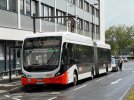Journeyman
Established Member
- Joined
- 16 Apr 2014
- Messages
- 6,295
Trolleybuses were largely a stopgap solution when tram systems began to contract. In London they were used as a means of efficiently using spare generation capacity after tramway closures, but as power stations reached life expiry, there was no point in keeping them, and the Routemaster was initially rolled out as a trolleybus replacement.
My mum used trolleybuses quite regularly in their final years in London, and recalled that they often ended up bunching badly because they can't overtake each other, and in bad weather they were constantly dewiring, and the conductor kept having to get out to mess with the poles.
I agree that if you're going to string up wires, go the whole hog and build trams. Trolleybuses always had significant drawbacks, and in the light of a rapid move to battery vehicles, there's no point in investing money in putting up the wires.
My mum used trolleybuses quite regularly in their final years in London, and recalled that they often ended up bunching badly because they can't overtake each other, and in bad weather they were constantly dewiring, and the conductor kept having to get out to mess with the poles.
I agree that if you're going to string up wires, go the whole hog and build trams. Trolleybuses always had significant drawbacks, and in the light of a rapid move to battery vehicles, there's no point in investing money in putting up the wires.



